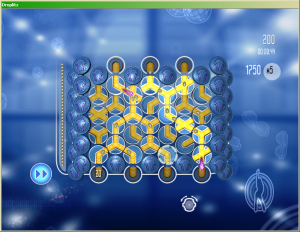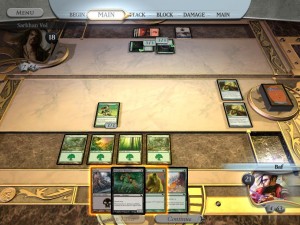Having acknowledged the problems with the Steam Trading Card system, I do my best to avoid them. Shortly after taking notice of the things last year, I adopted a few rules:
- No idling. Obviously. Sitting in a matchmaking lobby for a multiplayer-only game that no one plays any more is permitted, as long as I do it in good faith and play a match if one appears.
- No trading cards for money, or money for cards. “Not even once”, as they say. The Marketplace is a slippery slope, and besides, it strikes me as “easy mode”. Trading cards for cards seems like a better game.
- No buying games just for the cards. Although if a game I was thinking of buying anyway just happens to have cards, well…
Even with those limitations, I’ve managed to reach level 57 — not the big leagues, but higher than anyone on my Friends list. My journey to this point essentially has three stages.
First, I just did a little occasional trading with Friends, if we could come up with a trade that gave us both something we wanted. Indeed, at first, your Friends were the only people you could propose trades to; if you wanted to trade with anyone else, you had to Friend them first. And then, to execute the trade, you had to be online at the same time as them. Trading took place in an interface similar to the ones for player-to-player trades in World of Warcraft and other MMOs, both players dragging offers from their inventory and then hitting an “Okay” button, which would become automatically unpressed if the other player modified the trade on their end.
I suppose Valve was unsatisfied with the amount of trading and badge-making that such an inconvenient system produced, because they soon added ways to make yourself available for trade offers from non-Friends, as well as the ability to do trading asynchronously, sending offers that people could accept or reject on their own time, which made the new game-specific Trading Forums much more useful. Just how useful varies a lot from game to game, even today. The useful forum posts, from my point of view, are the ones with subject like “[H] Gravity Well [W] Force Shield 1:1”. (“[H]” and “[W]” quickly emerged as accepted notation for “have” and “want”, “1:1” means one-for-one, and “Gravity Well” and “Force Shield” are the names of two cards for Defy Gravity.) But a lot of the game-specific forums became clogged with spam along the lines of “1000+ cards 1:2”, without even any mention of whether those 1000+ cards included any for the game whose forum it was posted in.
My second phase began with the 2013 Winter Sale, when the reappearance of sale event cards provided additional impetus to complete badges. I had accumulated over 300 cards by then, simply by playing a lot of games and not making a lot of badges. Boosters, by the way, have never been a great source of cards. During the entirety of the Winter 2013 sale, when badge-crafting and therefore booster-dropping was at a peak, I got a total of two boosters. In the recent Summer sale, during which I reached level 50 and thus doubled my booster drop rate, I got three. But I keep on getting more card-bearing games — often without meaning to, through bundles. Even when I don’t buy any games, games that I already own suddenly get cards. At the time of the 2013 winter sale, the number of card-bearing games I owned and hadn’t got all the drops from yet was sort of perpetually hovering around 20-ish, despite my best efforts at milking them dry. So not only did I have what then seemed like a lot of cards, I had a seemingly inexhaustible source of more. So I tried my hand at being a card baron and posting general offers.
I didn’t spam the game-specific forums, mind you. I only posted to the forum of the official Steam Trading Cards group, the largest group on Steam. My terms were simple and, relative to the other card barons, fairly generous. I’d accept any 1:1 trade within a set, and any 1:2 or 2:3 trade across sets, regardless of whether I wanted the cards I received or not. My goal was simply to get more cards. And it worked for that purpose, for what it’s worth. I did quite a lot of trading for as long as I kept bumping my post to keep it on the forum’s front page, and made enough profit to keep my card count in the neighborhood of 300 even as I kept spending them on badges. I even managed to make a badge for a game I didn’t even own (Rising Storm/Red Orchestra 2 Multiplayer), which, at the time, seemed amusingly novel.
But at the same time, it was clear that most of my trading partners were taking advantage of me, securing my most valuable cards with greater quantities of what they considered trash. I wasn’t much concerned about market values, but the least valuable cards tended to be the ones from 15-card or 13-card sets. Consider cards as fractions of badges — for example, a card from a ten-card set is 1/10 of a badge. If you give me two cards from a 15-card set for one of my cards from a 5-card set, I wind up with more cards, but less badge. So I let my ad leave the front page and more or less stopped trading for a while, unless a Friend wanted something.
Phase 3 started when I learned about the third-party Steam Card Exchange trading bot. This completely changed trading for me. In particular, it let me follow the letter of the “no Marketplace” rule without following its spirit. The Card Exchange bot is a Steam user that you offer trades to like any other, but instead of a human being accepting or rejecting them, there’s a computer program, which usually means you get a reply just a few second later (unless it’s overloaded, as happened daily during the Summer Sale trading-frenzy). The bot assigns each card a value in “credits”, the value being determined by its price in the Marketplace, except that it assigns the same value to every card in a set, and values are not allowed to exceed 100 credits, to help prevent abuse. The bot will accept any trade where it’s getting at least as many credits-worth of cards as it’s giving, and if there are credits left over, it keeps track of them and applies them to future trades with the same person. It does have some limitations that the Marketplace doesn’t. If you want the last of a card it has in stock, you pay 50% more — presumably this is a big part of how it increases its stock. It won’t stock more than 8 of a card, so if it already has 8 of a card you’re offering it, your offer will be rejected. It won’t let your stored credits exceed 100.
(I find these limitations interesting, because they introduce some extra symmetry. You don’t just have lower bounds of zero cards and zero credits, but upper bounds as well. This means you can think of a personal store of n credits as (100-n) anticredits, which you can use to buy the gaps in the bot’s inventory.)
What this all means is that I now had a trading partner who wouldn’t try to bilk me, but which I could maximally exploit in good conscience. I’ve gone so far as to write a script to report the price of a full badgeworth of cards for every game in Card Exchange credits. (The Card Exchange has a page listing badge prices in US dollars, but this is misleading if you’re only trading with the Exchange.) I give it cards for expensive badges (when it lets me), and buy as much as I can of the cheap ones. I mentioned before that my first badge for a game I don’t own was an amusing novelty; at this point, if I make a badge for a game I do own, it’s complete coincidence.
I suppose the next step is day-trading: monitoring small price fluctuations and making a profit by repeatedly buying and selling the same cards. I haven’t gone that far yet, but honestly, I’m pretty far gone. Trading is no longer connecting me to other players, and I’m no longer aiming for badges for the games I like. The Card Exchange is almost as “easy mode” as the Marketplace. But hey, at least I’m not idling, right?
I few days ago, I idled. The game was Actual Sunlight, a short and text-heavy character portrait about depression and suicide, written in RPG Maker. Not exactly the sort of work you’d expect to have cards, but there it is. I played through it, assiduously seeking out every item I could press a button at to trigger an essay about how worthless the player character feels, and when I reached the end, and I still had one card drop left. So I started to replay it from the beginning, but got discouraged and stopped. (My patience was not helped by the game’s irritating unskippable opening cutscene, which includes an alarm clock going off multiple times.) I’m pretty sure I saw everything the piece had to offer, so I idled for a half an hour or so. The honorable thing would have been to just stop playing, and maybe pick it up again some time later, when I could look at it again with fresh eyes. But that last card drop itched.
Anyway, if you’re read this far, I invite you to trade with me. I currently have about 600 cards, and am willing to do just about any 1:1 in-set trade, as well as consider cross-set trades that don’t leave me with less badge.
 Comments(0)
Comments(0)
